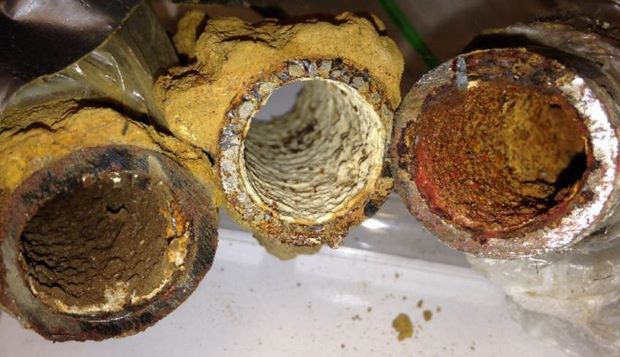RACINE, Wis. (AP) — The city of Racine had just under 11,000 lead pipe service lines delivering water to its nearly 80,000 residents in July, when the city announced it had received a $1.6 million grant through the state’s Safe Drinking Water Loans program.
The grant would provide enough money to replace about 400 lead pipes delivering water to Racine residents.
At that rate, it could take another 25 years to get to all of the lead pipe service lines on private property in the city.
The dangers of lead to the human body have been well-known for decades, but the process of removing old lead service lines from private property has crept along slowly — primarily owing to a lack of money.
A 2015 report by the Wisconsin Department of Health Services reported statewide tests on children showed the percentage with elevated blood lead levels was 4.6%. That same report found the percentage in the jurisdiction of the City of Racine Public Health Department was 9% for 1-year-olds and 10.2% for 2-year-olds, the Racine Journal Times reported.
By comparison, the percentage of children with elevated blood lead levels was 4.9% in Flint, Michigan, a city with internationally known for its dangerously poor water quality.
Further testing in 2016 showed the number of kids in Wisconsin who had so much lead in their blood to actually be lead poisoned (5 micrograms per deciliter) was 5% — twice the rate of the children of Flint, according to data from the Michigan Department of Health and Human Services.
In short, water in Wisconsin is oftentimes worse off than water in Flint.
There’s an across-the-aisle understanding that a large amount of federal money will most likely be needed to completely replace all of America’s lead pipes.
Joining Neubauer on a virtual luncheon hosted by WisPolitics.com on Sept. 21, State Sen. Robert Cowles, R-Green Bay, discussed Biden’s Build Back Better Agenda, which has three components: the American Rescue Plan Act, the American Jobs Plan, and the American Families Plan.
The second component is generally known as the infrastructure bill, with a price tag of around $2 trillion, including $45 billion for replacement of lead pipes.
Discussions on the bill are ongoing in Congress, with no Republicans showing support for it and a handful of Democrats opposing it, making it effectively impossible to pass at the moment unless a few change their minds.
As Cowles noted, Wisconsin has been slowly dealing with lead pipes for a long time. What the federal funds will provide, he explained, is a way forward.
Some Wisconsin cities are far ahead. Madison in 2001 committed to removing the last of its lead pipe service lines at a cost of less than $20 million. Green Bay removed its approximately 2,000 remaining pipes over five years in a project that was completed last year.
Other cities — like Racine — have a long way to go. Milwaukee, for example, has approximately 70,000 private lead pipe service lines that will have to be replaced.
While the state waits for further funding assistance, the city continues to monitor lead levels in the drinking water — as required by federal law.
The Safe Drinking Water Act was passed by Congress in 1974, but it wasn’t until 1991 that the Lead and Copper Rule was added. LCR limits the copper and lead concentrations at the consumer’s tap, a tricky bit of business since municipalities cannot force property owners to pay the thousands of dollars necessary to change out lead pipes.
Also at issue are the lead pipes concentrated in older, impoverished neighborhoods where homeowners often cannot afford the expense of removing and replacing the pipes or to bring in bottled water.
In order to determine the lead concentrations, municipalities must test the water at the tap.
According to Joel Brunner, the drinking water plant superintendent for the Racine Water Utility, the city is required to annually sample at least 50 sites with verified lead service lines.
If 90% of those results are below 15 parts per billion, the utility is deemed compliant.
If the 90th percentile is 15 ppb or greater, further sampling and public education is required, Brunner explained.
The Racine Water Utility is currently in compliance with the LCR.
In 2021, the utility collected 53 samples at the tap. The average concentration of lead was 2.6 ppb (median: 1.4 ppb; maximum: 20 ppb; minimum: 0.25 ppb; 90th percentile: 5.7 ppb).
Although the lead concentration was well below the limit set by the LCR, it is important to note there are no safe levels of lead exposure.
The Environmental Protection Agency notes that lead bioaccumulates — i.e. toxins building up inside the human body — can be especially harmful to infants, children and pregnant mothers.
Even low levels of exposure may lead to learning disabilities, among other negative health outcomes.
Dottie-Kay Bowersox, the city’s public health administrator, recommended that parents follow state guidance and have their children’s blood screened three times before the age of 3 and once a year afterward until they turn 6.
The city keeps an inventory of houses with lead pipes. Those who qualify for testing and grants for pipe replacement are contacted by the city.
Researchers began to understand the dangers of lead pipes to human health in the late 1800s, but the pipes continued to be used well into the 1940s.
This was owing, in part, to an organized effort by the lead pipe industry.
Richard Rabin, a researcher with the Massachusetts Coalition For Occupational Safety And Health who has published articles regarding the defunct Lead Industries Association and its efforts to promote lead, pointed out that lead pipes were recognized as a cause of lead poisoning in the late 1800s.
By the 1920s, he notes, municipalities had begun to prohibit the use of lead pipes to deliver drinking water.
“To combat this trend, the lead industry carried out a prolonged and effective campaign to promote the use of lead pipes,” Rabin wrote in a 2008 report published in the American Journal of Public Health.
The LIA campaign started in 1928 with an effort to influence plumbers, water authorities, architects, and federal authorities. The association also published books and articles promoting lead pipes over other materials, ignoring the health detriments. They talked up the benefits of lead, such as its lifespan of 35 years; whereas, the pipes made from iron — a popular material for pipes at the time — lasted only 16 years. The financial savings for municipalities was compelling, but only if they ignored or were blinded from the truths of the danger of lead.
The LIA also led a successful effort to have municipal codes changed in favor of lead pipes.
However, the evidence of the harm from lead pipes continued to mount until 1986 when Congress prohibited the further use of lead pipes. The legislation was not accompanied by funds to remove 100 years of lead pipe installation.
*** This article was originally written by Associated Press on October 11th, 2021. ***
There are many cities in Wisconsin that still use these lead based pipes in their water supplies.
Feel free to comment below.





You are not authorised to post comments.